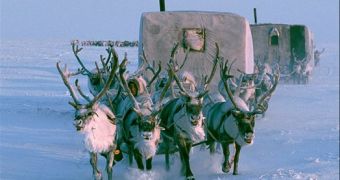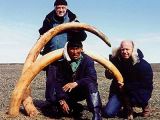While in North America, many Indian and Inuit (Eskimos) groups had their subsistence linked to reindeer and hunt them, in Eurasia, many Arctic tribes had an even closer connection with the sole larger survival of the Ice Age, as the species have been herded for about 4-5,000 years, from the Sami (Lapps) to Nenets, Khants, Evenks (Tungus), Yukaghirs, Chukchi, Koryaks and Dolgans.
Even so, reindeer are not totally domesticated, as they generally roam free on the Arctic pastures. A single owner can possess hundreds or even thousands of reindeer. Traditional nomadic reindeer herders migrated with their herds between coast and inland areas, as the animals move in the spring to the north for mating and giving birth, but especially escaping blood sucking mosquitoes and flies, which swarm in the tundra in the summer, and return during the fall, to avoid tough Polar winters.
During the annual migration route, herds are keenly tended. Still, reindeer have never been bred in captivity, and individuals are just tamed for milking, draught animals or beasts of burden. In Siberia, the reindeer is also ride on, but the Siberian race is larger than the Scandinavian one.
The traditional nomad life linked to reindeer herding today survives mostly in the Russian Siberia.
One example are the Dolgans, inhabiting eastern Taymyr Peninsula (north central Siberia), a region which experiences winters with -60o C and winds of 120 km (75 mi) per hour.
The 2002 Census counted 7,261 Dolgans. Dolgans speak a dialect of the Yakut (a Turkic language), thus are quite recent in the area and not a Native Paleosiberian group.
Their ethnic group seems to have emerged in the 19th, from a group of Evenks, Yakuts, Enets. Traditionally, the Dolgans were nomadic reindeer breeders and hunters, but the Soviet power forced them to settle in kolkhozes during the Soviet times. They were involved during those times in reindeer breeding, hunting, fishing, dairy farming and market gardening, but after the fall of the Soviet Union, some returned to the traditional ways.
Dolgans use everything from the reindeer: milk, meat and skin to antlers (in high demand on the Asian market, as powdered are sold as an aphrodisiac, nutritional or medicinal supplement) and the fatty marrow of the bones.
Traditional Dolgans live in "baloks", nomad housings covered by reindeer leathers and dragged over sleds by reindeer (up to 6 pairs) while on the vast tundra in the search of new locations. A balok is big enough to house an entire family. Even if inside a balok there is a wood stove, the temperatures in many cases do not overcome -15o C inside. And in many cases, wood is found at distances of 30 km (19 mi).
For toddlers, the Dolgans use sled-cradles and are located amongst reindeer which provide heat. During the winter, the Dolgans wear thick overcoats, combining reindeer leather and other skins (like polar fox).
Dolgans hunt for wild reindeer (for getting meat) but also use traps for fur animals, like polar foxes.
Like in the case of many Arctic people whose life is linked to the reindeer, Dolgan's story of genesis also includes their base animal.
Dolgans were once Shamanist, but they were forced by the Russians to pass to the Russian Orthodox Church; but their Christianity combines old animistic beliefs with today's traditional holidays.
Today, the Dolgans face environmental issues in their remote north. 1 million herded reindeer live in Taymyr, and there are just a few thousands people. Fur, meat and antlers are sold, an important source of income. Overhunting is killing the last herds of wild reindeer, as many Dolgans turned from herders to hunters, and the too intensively herded reindeer stamps the fragile tundra soil.
The nickel, copper and cobalt fabrics of Norilsk are big contaminant factors.
The ban on the elephant ivory trade turned the Japanese and Chinese market towards the fossil mammoth ivory, whose price boomed. The Dolgans change mammoth tusks for snowmobiles, and the increased number of snowmobiles in the tundra is an added factor of pollution and human pressure on the pristine environment.
Now the warming temperatures thaw out the permafrost (the frozen soil) to show off the fossilized bones of prehistoric valuable fossils like mammoths and woolly rhinos, for which private collectors and institutes will pay generously for the best specimens.
In some places, the bones pop up to the surface at every few meters due to the rapid thawing and break up of the permafrost. Russian traders pay $8-156 per kg of mammoth bones, but curled tusks, sometimes up to 5 m (15 ft) in length, are the most priced pieces. If lucky, a Dolgan can earn $7,800 in just one day, the income for a year.
Still, Russian traders are those who make most of the money: private collectors will pay up to $20,000 for a well preserved mammoth tusk, a head with two tusks in great condition means $31,000, while a reconstructed mammoth skeleton can fetch between $150,000 and $250,000.
Alcoholism is another problem, just like in many other Siberian groups. You will see people changing a polar fox skin for a bottle of vodka...

 14 DAY TRIAL //
14 DAY TRIAL // 
